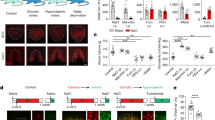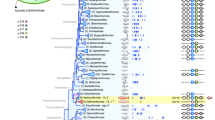Abstract
IT is generally assumed that neuronal function is critically dependent on a relatively stable chemical environment. In most animals investigated homeostasis of the neuronal microenvironment is achieved by regulation of the chemical composition of the body fluids and, in higher vertebrates1–3 and insects4, by additional homeostatic control within the nervous system. The axons of an extreme invertebrate osmoconformer5 (the worm Mercierella enigmatica Fauvel) have been shown, however, to adapt and to continue to produce sodium-dependent action potentials when exposed to massive blood dilution6,7. It has also been suggested that short-term protection is provided by a facultative blood-brain barrier which enables the axons to adapt relatively slowly to hyposmotic stress7. We now report that the effects isosmotic and hyposmotic dilution of the surrounding medium on the giant axons of Mercierella are direct, and that axons respond rapidly to changes in ionic concentration and adapt to extreme osmotic stress almost immediately.
This is a preview of subscription content, access via your institution
Access options
Subscribe to this journal
Receive 51 print issues and online access
$199.00 per year
only $3.90 per issue
Buy this article
- Purchase on Springer Link
- Instant access to full article PDF
Prices may be subject to local taxes which are calculated during checkout
Similar content being viewed by others
References
Davson, H. in Physiology of Cerebro-spinal Fluid (Churchill, London, 1967).
Rapport, S. I. Blood–Brain Barrier in Physiology and Medicine (Raven, New York, 1976).
Abbott, N. J. & Treherne, J. E. in Transport of Ions and Water (ed. Gupta, B. L., Moreton, R. B. & Wall, B. J.) (Academic, New York, in the press).
Treherne, J. E. in Insect Neurobiology (ed. Treherne, J. E.) (North-Holland, Amsterdam, 1974).
Skaer, H. le B. J. exp. Biol. 60, 321–330 (1974).
Carlson, A. D. & Treherne, J. E. J. exp. Biol. 67, 205–215 (1977).
Treherne, J. E., Carlson, A. D. & Skaer, H. le B. Nature 265, 550–553 (1977).
Baskin, D. G. Tiss. Cell 3, 579–588 (1971).
Author information
Authors and Affiliations
Rights and permissions
About this article
Cite this article
TREHERNE, J., BENSON, J. & SKAER, H. Axonal accessibility and adaptation to osmotic stress in an extreme osmoconformer. Nature 269, 430–431 (1977). https://doi.org/10.1038/269430a0
Received:
Accepted:
Issue Date:
DOI: https://doi.org/10.1038/269430a0
Comments
By submitting a comment you agree to abide by our Terms and Community Guidelines. If you find something abusive or that does not comply with our terms or guidelines please flag it as inappropriate.



